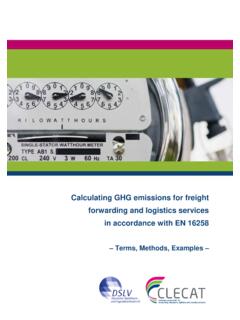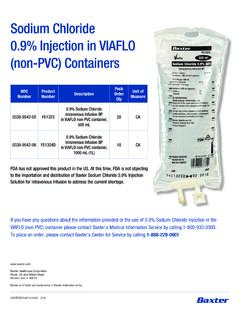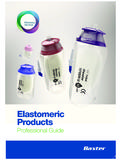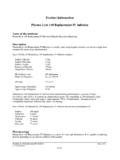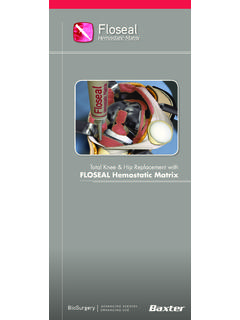Transcription of Logistics Best Practice Guide - clecat.org
1 Logistics Best Practice Guide A Guide to implement best practices in Logistics in order to save energy and reduce the environmental impact of Logistics . 2 CLECAT s Best Practice Guide to save energy and reduce emissions PREFACE .. 5 I. Introduction .. 5 II. Aim of the 5 1. Promoting best Practice ..5 2. Best Practice is you!..6 III. General areas for 7 1. Technology ..7 2. 3. Smart/strategic 10 IV. Concluding 12 BEST Practice 13 I. Technical .. 13 1. Information Technology for Efficient Road Freight Operations (Department for Transport, UK with RHA and FTA).. 13 2. Telematics for Efficient Road Freight Operations (Freight Best Practice / Department for Transport, UK).. 14 3. Solar roof to save energy (FedEx, USA).. 14 4. Fuel Saving Devices (Department for Transport, UK).
2 15 5. Fuel Management 15 6. SmartWay, US Environment Protection Agency.. 15 7. Reduction of Waste through an Oil Treatment Plant .. 16 8. Reduced Water Consumption by Using a Modern Washing Facility .. 16 9. Introduction of Power Saving 16 10. Double-deck Cargo for Increased Efficiency (Emons Cargo).. 16 11. Use of Intermodal Transport (Ewals Cargo Care).. 16 12. Monitoring Fuel Consumption (Ewals Cargo Care).. 17 13. Reduction of Emissions by Use of Low-emission vehicles ( Therkelsen A/S) 17 14. Improved Vehicle Utilization through Mobile Sludge Drainage (Joma Slamsugningsservice AB) .. 17 15. Eco Guardian Lower Emissions and Fuel Consumption by a Comparative Trial of Vehicle Technologies (J. W. Suckling Transport Limited) .. 18 16. Water-saving Equipment and Use of Rainwater for Vehicle Cleaning (Metzger Spedition GmbH).
3 18 17. Reduction of Water Consumption (Transportes Campillo SA).. 18 18. Hybrid shunting locomotive (Port of Rotterdam).. 18 19. Transport of waste materials by water (London Waste and Bywaters/SmartBarge Ltd, UK) .. 19 20. Improvement in aerodynamics (Aspray Transport Ltd / Freight Best Practice ) 19 3 21. The Benefits of Operating Electric Vehicles in an Urban Environment (TNT / Freight Best Practice ).. 19 22. Innovation Secures Future at Rural Haulier (Andrew Black Limited) .. 20 II. 21 1. The European Environmental Agency s Good Practice in Logistics 21 2. Fuel Management for transport operators (Thorntons plc).. 21 3. Fuel saving tips, Department for Transport, 21 4. Performance Management for Efficient Road Freight 22 5. BESTUFS Best Urban Freight 22 6.
4 Consolidation of Transports (Sieber).. 22 7. Transport Collaboration Carpathia Express (Czech Republic).. 23 8. Telematics at SME s (Sieber).. 23 9. Improvement in Utilization through Customer Incentives (Aamaals Milj hantering).. 24 10. Measuring, Monitoring and Reducing Fuel Consumption (Egon S rensen Transport A/S) .. 24 11. Tankshare Improved Utilization through Groupage Freight Service (J. W. Suckling Transport Limited).. 24 12. Improved Material Planning through Communication (K. I. Transport).. 24 13. Security and Resource Efficiency through an Integrated Management System (Nijman/Zeetank Holding BV) .. 25 14. Loss Prevention for the Vehicle Fleet (Nobilia International) .. 25 15. Reduction of Environmental Impacts by Management (Otto G rgens Spedition-Transportlogistik / L beck).
5 26 16. Regulations for Good Common Practices in the Road Transport of Dangerous Goods (Trancister Sociedade de Transportes SA) .. 26 17. Improved Efficiency through New Information and Communication Technology (NICT) (Transportes Lu s Sim es).. 26 18. Implementation of an Environmental Management System (EMS) (Transportes Ochoa SA) .. 27 19. BT Transport Exchange Group Improving efficiencies within a scheduled trunking 27 20. Cargo Domizil Intermodal less than truckload 27 21. INDITEX Pro-Kyoto Project .. 28 22. MAPEI - Optimising goods collection cycle 28 23. Mercadona and Renfe: Intermodal Collaboration 29 24. Sharp s collaboration with the green transport marketplace, 29 25. Cargo shuttle between Port of Barcelona and SEAT .. 30 26. Freight Best Practice Fuel Efficiency Intervention Trials - How to Test and Save 30 27.
6 Tesco Sets the Pace on Low Carbon and Efficiency (TESCO / Freight Best Practice ).. 30 28. Short Haul Rail Freight (Lafarge Cement Ltd / The Malcolm Group / Freightliner Ltd / Freight Best Practice ).. 30 29. Transportation of healthcare products by inland navigation (Baxter) .. 31 30. Shell Chemicals Europe and Bertschi AG network redesign .. 31 31. Reconfiguration of the supply chain structure (IKEA) .. 32 32. Lovosice Inter-Modal Terminal (CD / Duss Terminal) .. 32 4 III. 1. Impact of EcoDriving on emissions and fuel 33 2. The Fuel Efficient Truck Driver s 33 3. Engine Idling (case studies by Lloyd Fraser Group plc, Allies Bakeries Ltd, Ralph Coleman International Ltd, Leggett s Transport Ltd).. 33 4. Reduced Fuel Consumption and Accidents through Driver Training (Berger Beteiligungsgesellschaft mbH).
7 34 5. Bonus System to Encourage Drivers to Drive Safely and Fuel-efficiently ( Therkelsen) .. 34 6. Driver Training for Improved Safety and Fuel Efficiency (Metzger Spedition GmbH) .. 34 7. Reduction of Accidents by an Internal Training Programme: Challenge of the Day (Nijman/Zeetank Holding BV) ..34 8. Safe Loading and its Implications (Otto G rgens Spedition-Transportlogistik / L beck).. 35 9. Reduction of Fuel Consumption supported by Monitoring (Transportes Campillo SA) 35 10. Reducing Accidents by Implementing a Safety Manual (Transportes Lu s Sim es).. 36 11. Improved Efficiency through use of a Guidance and Communication System (VSV Frakt AB).. 36 12. Driver Training for Improved Safety and Fuel Efficiency (Wullkotte & Hackmann Trucking & Transport GbR) .. 37 13.
8 Fuel Saving in a Scottish Haulage Fleet (John Mitchell [Grangemouth] Ltd / Freight Best Practice ).. 37 LITERATURE AND USEFUL LINKS .. 38 5 Preface I. Introduction The challenge to mitigate the consequences of human activities on the environment has become one of the major concerns characterising and influencing today s business world. The battle to preserve our environment has gained momentum over the years and is now part of the policy of a growing number of enterprises. The ongoing battle against climate change owing to GHG emissions has also come to the fore in policy and business alike. These two different yet intertwined predicaments have not failed to impact upon Logistics activities, questioning some of the basic principles of this discipline. Transport services appear to be one of the biggest sources of CO2 emissions and some of the transport emissions are also pollutants.
9 This is however an industry, which is, on the one hand, indispensable for growth and employment and yet on the other hand has enduring difficulties freeing its dependence on fossil fuels . This being said, Logistics is not only transport: a more wide-range view on what can be done to improve the environmental performance of Logistics can contribute to our industry s footprint in an area where legislation is finding it increasingly difficult to step in. The need to decrease emissions, but also to save energy and money, should be at the heart of our companies thinking. Luckily these needs lessening emissions, decreasing the use of energy and saving money are connected and may respond to the same drivers: not only the Logistics service provider, but also the transport user are likely to benefit from savings that may be environmental as well as economical.
10 There is an abundance of possibilities and many companies have already found ways to improve their business models with individual solutions, which have the potential to be developed into best practices. Their experience is the source of the best Practice models that benefit and encourage others to do the same. In other words we are not trying to re-invent the wheel in this booklet: we are trying to disseminate the best practices that we have managed to collect from different sources, and make them available to others, whether they are Logistics service providers or users. Whilst this may appear a minimalist approach, we believe it can be extremely helpful in an area where sharing knowledge and know-how is crucial. II. Aim of the exercise 1.
